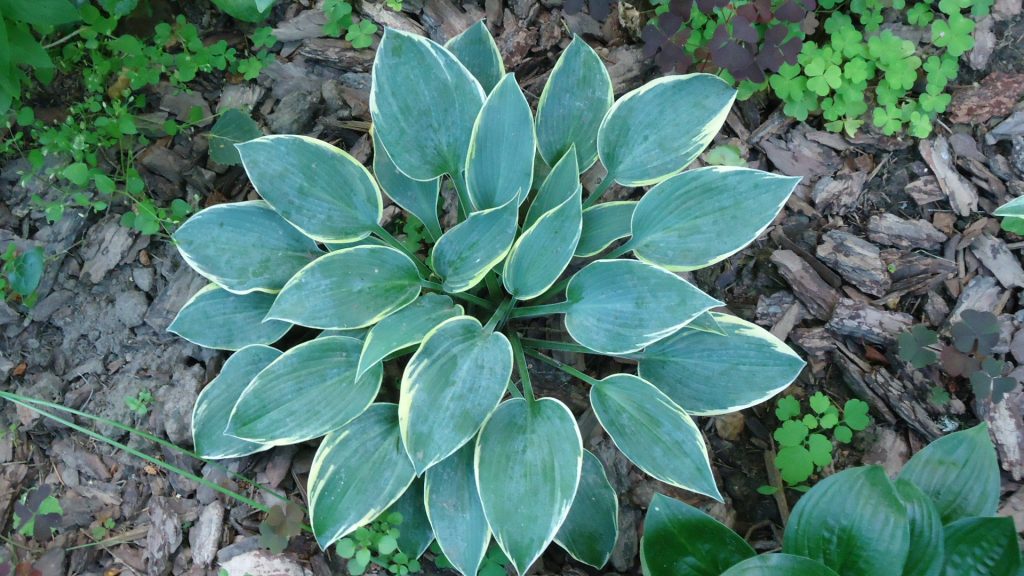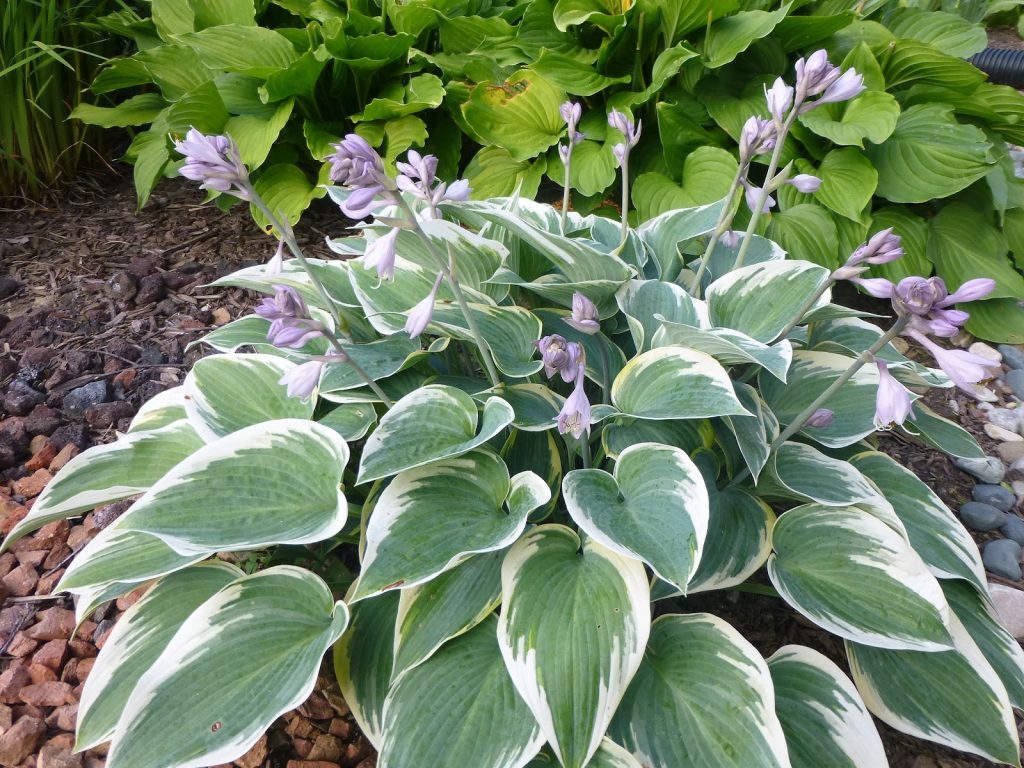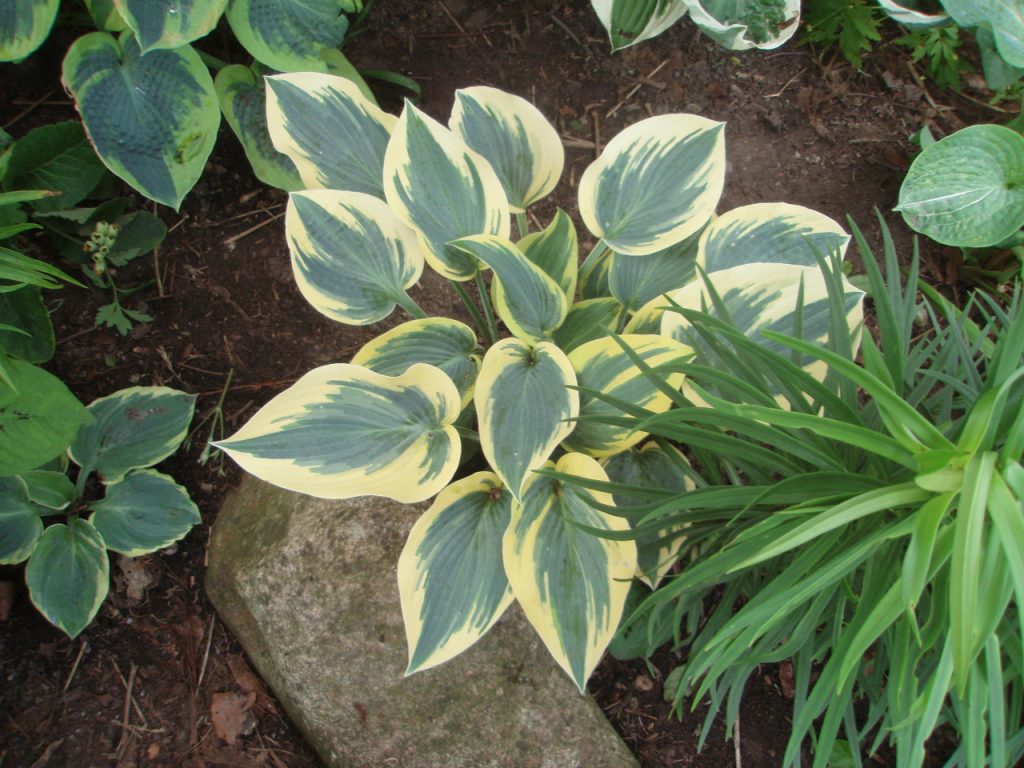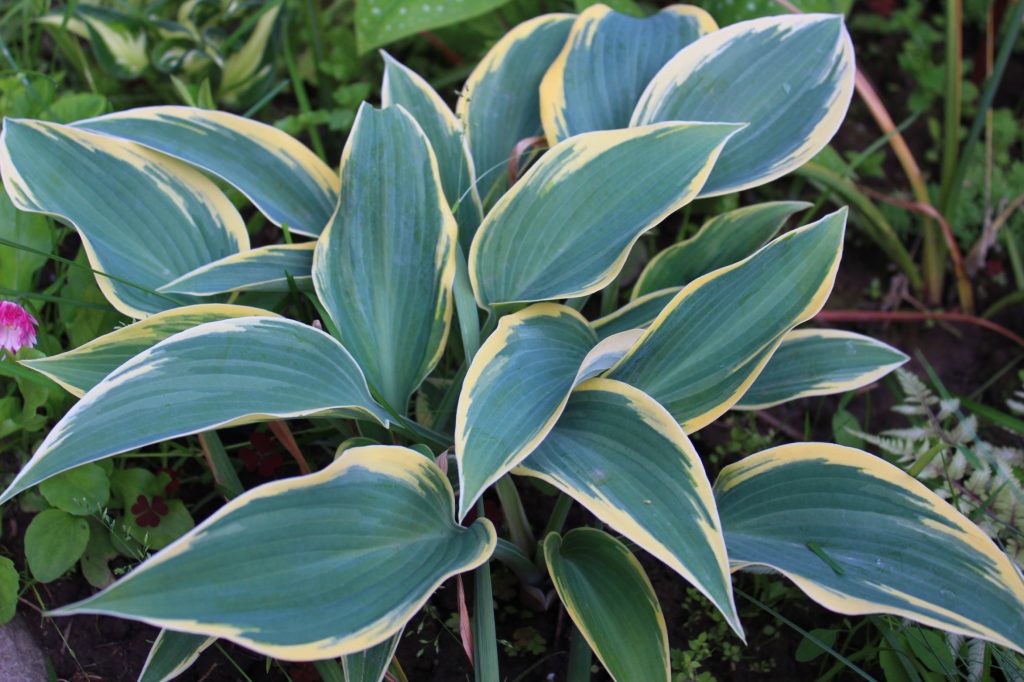Hosta First Frost - How to Grow a Plant
Hosta First Frost is an ornamental herbaceous perennial from the Asparagus family. It has been known since 2002 and is a sport of the Chalceon function (originators: P. Scolnik, B. Solberg). The translation of the name sounds like "first frost", emphasizing the original color of the leaves, as if wrapped around the edges with patterned frost.

Hosta first frost photo and description
Description of the variety
First Frost is a medium sized hybrid function. It reaches a height of 25-40 cm, in diameter - 70-80 cm. The bush is compact, lushly leafy, fountain-like.
The length of the leaf is 15-18 cm, the width is 12-13 cm. The leaf plate is bluish, at the edges it is golden yellow (by autumn, the main background becomes dark green, and the dashed border becomes cream).
Flowers appear in early or mid-July and bloom in August. Small pale lavender bells grow in inflorescences on tall, leafless peduncles. The root system is powerful, branched, superficial.
Landing features
First frost with an open root system is best planted in April, and specimens in a container throughout the summer.

Hosta first frost description photo
When purchasing a seedling, pay attention to the quality of the goods: there should be no extraneous stains, damage, lethargic and dry leaves on the function.
Like any host with variegation, First Frost will be more decorative in partial shade (rather than full shade). She can grow in a sunny place, but needs midday shading.
In the case of a close occurrence of groundwater, it is necessary to build an embankment for the plant and lay good drainage (broken brick or small pebbles like pebbles).
The function prefers loams with a neutral or slightly acidic reaction, but in principle it is not demanding on the soil. Reacts gratefully to an increase in fertility - the introduction of organic fertilizers during planting. The distance from the planting pit to other perennials is 45-50 cm.
Technology
The planting hole is dug deeper and wider than the earthen coma of the plant in order to pour more nutrient substrate (depth and width - 50-70 cm).
Subsequent stages:
- A drainage layer is laid on the bottom.
- Garden soil is mixed with peat, compost, rotted manure and the hole is covered by a third.
- Pour a bucket of water and allow moisture to be absorbed.
- For a seedling with an open root system, a slide is poured, along the slopes of which the roots are carefully straightened; the container function is simply transshipped along with the earthen lump.
The host is watered, sprinkled with the remaining soil mixture, tamped and mulched.
Care
The function needs regular watering, moderate feeding and pre-winter pruning. A few simple maintenance measures are required for good growth and excellent decorative effect.

Hosta first frost photo
Watering
For good growth of the funkia, moderately moist soil is needed, so it should be watered 2-3 times a week (in the absence of rainfall).
1-2 buckets of water are consumed per bush, depending on the size.Watering is desirable in the morning, trying not to wet the leaves.
Top dressing
You need to feed the funkia in spring and autumn, mulching the bush with compost or other organic fertilizers. After laying the mulch, the bush is well watered.
Additionally, you can carry out top dressing before flowering using water-soluble mineral complexes.
Pruning and preparing for winter
Dry peduncles are cut after flowering so that they do not spoil the decorative shape of the bush. When the leaves turn yellow and lie on the ground, they carry out pre-winter pruning - they cut off the entire ground part.
Despite the plant's frost resistance, it is better to cover it with a layer of dry foliage for the winter.
Reproduction
The hybrid variety First Frost cannot be propagated by seed, since the varietal characteristics will not be preserved.

Hosta first frost description
The function reproduces successfully by dividing the bush, but it is better to do this 5-6 years after planting.
- The bush is dug up and carefully divided into several parts with an equal number of buds and roots.
- Delenki are planted in partial shade in loosened, fertilized and moist soil.
Cutting is another popular method for breeding hosts.
- A rosette shoot is cut off "with a heel", treated with Kornevin and deepened into a wet substrate right outside (in light shade).
- On top of each stalk, cover with a plastic bottle to create a greenhouse effect.
- For successful rooting, it is necessary to maintain soil moisture and regularly raise the cover - to ventilate.
Diseases and pests
This hosta is highly resistant to diseases and harmful insects. Potential risks for her are slugs, snails and caterpillars - they eat foliage, gnawing ugly holes. However, the leaves of First Frost are distinguished by their density and rigidity, which is why they rarely seduce pests. For prevention, it is recommended to sprinkle the soil around the bushes with soda, tobacco or sharp stones.

Hosta first frost reviews
Excessive waterlogging can provoke fungal diseases and rot. It is necessary to observe the correct watering regime, disinfect garden tools, and maintain quarantine for newly arrived plants. A diseased hosta has yellow or brown spots, leaves wither, and growth stops. The affected parts are cut off, the bush is treated with a fungicide and transplanted to a new place. If it is not possible to save the function, it must be completely burned without throwing it into the compost.
Application in landscape design
The host is often used in the landscape design of gardens, parks, summer cottages. Plus, it grows well and looks great in a pot or container. This allows you to use it for landscaping gazebos, terraces, loggias, verandas.
The First Frost variety can serve as a variegated tapeworm on a green lawn, an original living border, an addition to flower beds, rockeries and mixborders. It is in perfect harmony with conifers, cereals, ferns, geyher, monochromatic varieties of funkia. In flower beds, it is successfully combined with daylilies, roses, delphinium, irises.
Testimonials
Judging by the reviews, First Frost is one of the most popular funky among gardeners. She rarely gets sick, tolerates heat and cold snaps. The first year (or two) after planting, the bush can grow at a slow pace, but then it quickly gains momentum, becomes lush and thick.
According to the descriptions of flower growers, the hosta gratefully reacts to feeding, delighting with accelerated growth and dense, bright foliage. The shrub retains its seasonal decorative effect for a long time - up to frost. It successfully overwinters and wakes up among the earliest plants in the spring.

